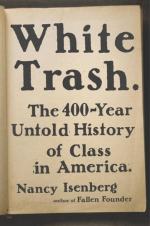|
This section contains 1,574 words (approx. 4 pages at 400 words per page) |

|
Summary
Isenberg begins her study in the sixteenth-century alongside the beginning of English exploration to the New World. The rhetoric surrounding the new territory was rooted in less of a practical standpoint, and more of a propagandist one. Isenberg first calls on the writings of English intellectuals and cousins, Richard Hakluyt the elder and the younger. Isenberg combines the work of the younger Hakluyt as well as other popular writers to demonstrate the intellectual landscape of England.
The general English sentiment of the time was that idle or unused land equated to wasted land. Hakluyt attached the term "empty" to the newly discovered land of America, implying the continent was lying in wait for the English to commercialize it. In his carefully constructed model for a working colony, he recognized the need for people to...
(read more from the Chapter 1: Taking out the Trash: Waste People in the New World Summary)
|
This section contains 1,574 words (approx. 4 pages at 400 words per page) |

|




